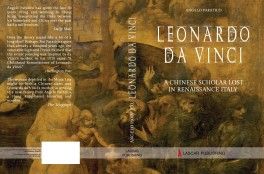If you would like to know more about this subject, see my book Leonardo Da Vinci. A Chinese Scholar Lost in Renaissance’s Italy, due to be released on 27th of March, 2015 in Hong Kong by Lascar Publishing.
Two weakness leaning on each other create a strength
That’s why half of the world leaning on the other half is more solid.
Leonardo Da Vinci – Cod. Atl. 244v.
It is likely that Leonardo’s elementary schooling was at Vinci, his birthplace, not in Florence and it seems that he did not receive, even in the following years, any type of formal education, perhaps that’s why he then called himself omo sanza lettere or an illiterate man. Giorgio Vasari, his not always reliable biographer, wrote that he attended for a few months a school of abacus but then he posed such difficult questions to the point of confounding his teacher: a clear sign of his precocity and bright intelligence. Certainly he did not go to school, as we intend today. This can be gleaned from the fact that he used his left hand to write. In Italy this hand is still associated with the devil and, up to a few years ago, was corrected by forcing children to switch to the right. I remember one of my classmates in high school who could write with both hands. His name is easy to remember: was the same of one of the main character in Garcia Marquez’s novel One Hundred Years of Solitude. Pietro Crespi, well I remember that Pietro told me that he had been compelled to switch to the right hand when small at the elementary school, getting badly smacked by the teacher.
Leonardo, the left-handed boy was left unchecked, so much so that he was even allowed to develop mirror writing, a thing natural in some left-handers and not originating from his desire to be secretive, as most people still think. Indeed Leonardo could also write with his right hand as well as with his left hand but going from left to right in a somewhat clumsy way. A further proof of the absence of regular schooling is the fact that he never really mastered Latin and Greek, even if he could read some passages of Latin when the subject attracted his interest. We still see Leonardo in his notebooks, already over 40 years old, trying to do exercises of Latin grammar and making some simple mistakes.
Benvenuto Cellini wrote that King Francis I of France told him that Leonardo had some knowledge of Latin and we can also see that he possessed some very elementary notions of Greek.[1] But not only was his Latin not good, even his Italian was insufficient as we can glean, once more, from his notebooks, especially in the Codex Trivulzianus kept in Milan, where he is constantly trying to enrich it by adding new words to his vocabulary.
Lack of good Latin in the end proved a blessing more than a curse forcing Leonardo to enhance direct observation, instead of blindly follow the words of the old masters, like Aristotle, Pliny and Plato. Only during his maturity he had access to ancient learning, when more and more works were made available in vernacular Italian, with the spreading of the printing presses.
Another interesting point worth noting is that he seems not to have received any regular religious training, which had always been mandatory for schoolchildren. Hence the notation reported by Giorgio Vasari in the first edition of his biography, dated 1550, that
Leonardo was of such heretical frame of mind that he did not adhere to any kind of religion, believing that it was perhaps better to be a philosopher than a Christian.[2]
This sentence was censored in the second edition of 1568 but there we can still find the following one, which possesses a strong Buddhist flavour:
Walking around in places where they were selling birds, he was buying them paying the price, to set them free, giving back their freedom.[3]
The possibility that he may have been taught by his mother, Caterina, not to harm all living creatures and not eating meat should also not be discounted.
Francesco Melzi, Leonardo’s most trusted pupil, in the draft of Leonardo’s Treatise of Painting had noted down a list of 18 notebooks by Leonardo but half or more of them are missing,[4] and we cannot rule out new surprises in the future.
The Codex Madrid I and II, containing 192 pages of his writings and sketches dealing with mechanic and geometry were rediscovered only in 1966 at the National Library in Madrid were they had been sitting, mislabelled, for two hundred and fifty years.
__________
[1] Cellini B. I trattati dell’Oreficeria e della Scultura Florence 1857. p. 226.
[2] Vasari G. Vite degli Architettori Pittori et Scultori Part III, Florence 1550.
[3] Vasari G. Vite degli Architettori Pittori et Scultori Part III, Florence 1565.
[4] Vezzosi A. Sabato A. Leonardo Florence, 2006.

